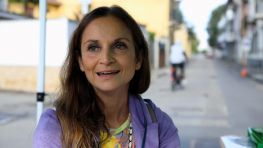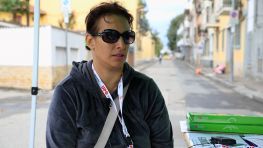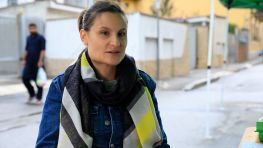 Elisa Di Tullio
Elisa Di Tullio Laura Rosati
Forty years of births at home in the Biellese area.
Laura Rosati after graduating from high school in Biella decides to undertake studies in obstetrics in Vercelli. The first birth she witnessed was probably decisive for Laura's future choices. It was a particularly violent birth, as often happened in those years, in which the role of the parturient mother was completely underdetermined by the choices of the medical staff.
Precisely in that historical period, full of changes, a movement was being born focused on the humanization of childbirth, also on the basis of the experience of Michelle Auden, a French doctor who had set up one of the first delivery rooms where women could choose how and with what times to give birth to their children.
After her first work experience, in the small hospital of Cuorgnè, she took part in a conference in 1985 that marked both her history and that of Italian gynecology. "The cultures of childbirth" was a milestone in the assistance of home births and more generally in the process of humanizing childbirth in health facilities. For Laura, the path of care for pregnant mothers and gestation at home begins here. Over the next forty years, Biellese women will be able to count on her experience and sensitivity to bring to light over 500 children within the reassuring walls of their homes.
Video table of contents
- Born at home in Ponderano.
- Studies in Biella and the School of Obstetrics in Vercelli.
- The school of obstetrics in Vercelli: a violent birth.
- The first experience in Cuorgnè.
- From the 1985 Conference "The cultures of childbirth" to home care.
- The beginning of home work with my friends and the first experiences in the field: reconciling contemporary medicine with the knowledge of tradition.
- The changes in the hospital system with respect to childbirth.
- "Natural" does not mean not governed but governed with balance.
- My work in the Biella area and my relationship with the territory.
- Experiencing pregnancy and motherhood has an important cultural result, a moment of exchange.
- Home birth, how it works.
- The relationship makes the difference between care in the home and in a hospital.
- Breastfeeding and home birth: a perfect combination. Out of 500 deliveries that I attended, only three mothers did not breastfeed.
- Post-partum and breastfeeding: there is no delegation to third parties but there is still a relationship and assistance. There is a lot of prevention work.
- Breastfeeding is the natural continuation of motherhood.
- At one time, animal milks were given which also led to death from enterocolitis and other complications.
- If a mother does not feel like breastfeeding, it is a choice that must be respected: better an artificial milk given peacefully than a natural milk that makes the mother uneasy.
- The duration of breastfeeding: constant listening.
- The role of the father is fundamental. Fathers are usually more concerned than mothers.
- The ecstasy of love in the family.
- Fathers are swooning if they aren't involved in the right way.
- The role of pets and siblings in home births.
- Sometimes there is no happy ending, fortunately very rarely.
- If you want to take this path: sisterhood, love for family narratives and a 360-degree education.
Interview information
Country: IT
Region: Piemonte
City: Ronco Biellese
Suburb: Case Sparse
Urls: Associazione La Cicogna
Laura Rosati
Date of birth: 01-27-1960
City: Ponderano
School: Professional qualification
Profession: Other
Languages: Italiano
Document by: Luca Ghiardo
Video by: Luca Ghiardo
Created: 13-09-2022
Questo video fa parte del seguente archivio
Breastfeeding: forms and practices of humanity
Breastfeeding: forms and practices of humanity
Breastfeeding is unanimously recognized by the main world health authorities as a fundamental health protection in the short, medium and long term for both the baby and the mother, offering biological, nutritional, emotional, relational and economic benefits.
The most important international scientific societies recommend giving the baby only breast milk for the first six months of life and subsequently accompanying the introduction of other foods with breastfeeding at least for the entire first year of the baby's life, but also up to two years and over if mother and child so wish.
This archive contains some testimonies of mothers and midwives aimed at deepening this theme by offering points of view anchored to individual experiences and sensitivities.






